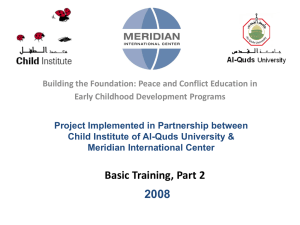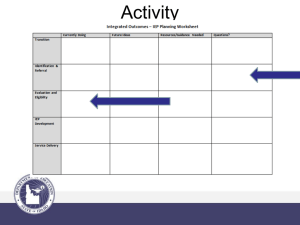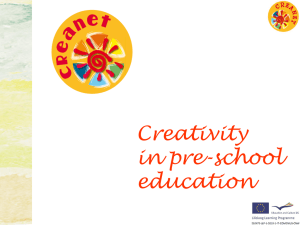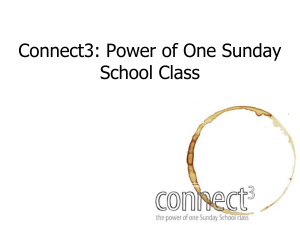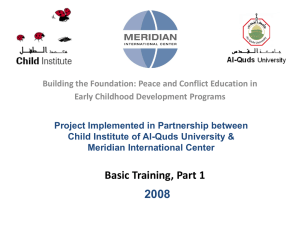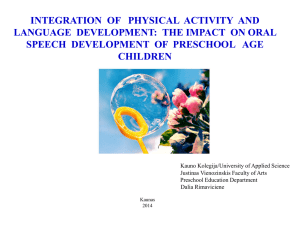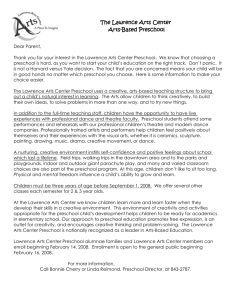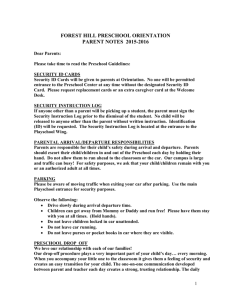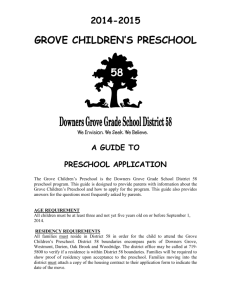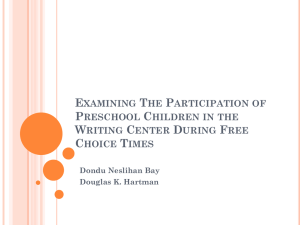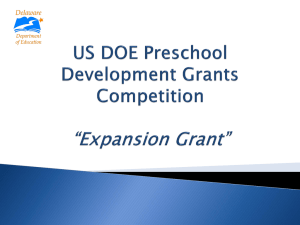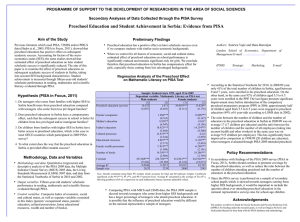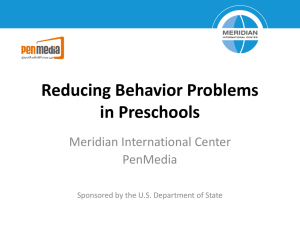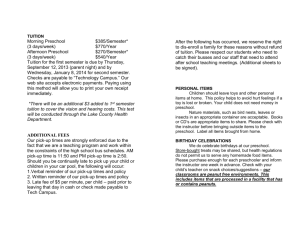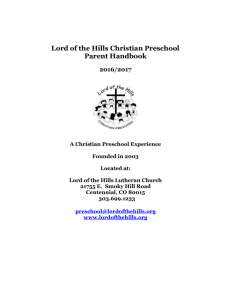Ajay Chaudry`s Presentation - NYU Steinhardt
advertisement
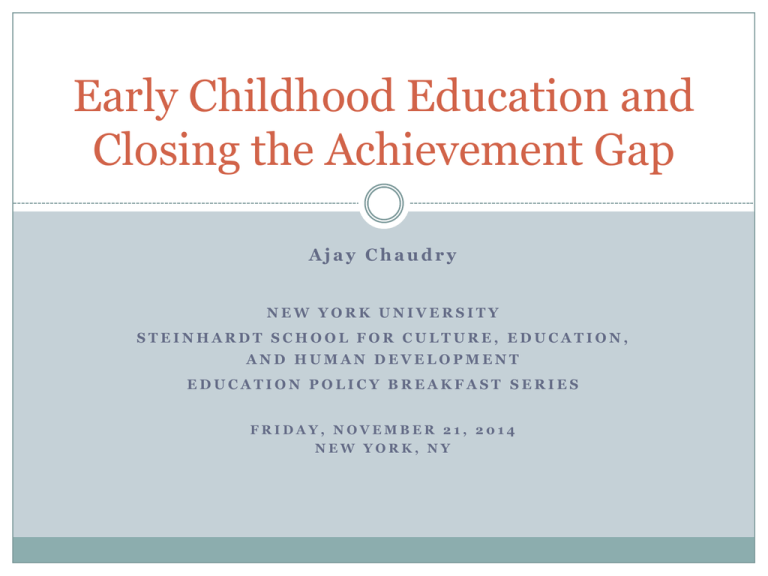
Early Childhood Education and Closing the Achievement Gap Ajay Chaudry NEW YORK UNIVERSITY STEINHARDT SCHOOL FOR CULTURE, EDUCATION, AND HUMAN DEVELOPMENT EDUCATION POLICY BREAKFAST SERIES FRIDAY, NOVEMBER 21, 2014 NEW YORK, NY Presentation Outline & Five Main Points 1 1. The Achievement Gap is Wide, It Begins Early and It Deprives Us All 2. High-quality early childhood education is a direct, effective, and necessary response to reduce achievement gaps and give all children a fair shot. 3. There are pronounced gaps in access to early learning and preschool education and the quality of much early education contribute to growing gaps in school readiness. 4. Target Needs within a Goal of Universality 5. Address Access and Quality Gaps Together The Educational Achievement Gap by income is Large & Growing 2 The Gap Begins Early 3 Income (90/10, 90/50, 50/10) School Readiness Gaps at Kindergarten Entry, firsttime kindergartners Acbievement Gap (standard deviations) 1.4 1.2 1 0.8 Math 0.6 Reading 0.4 0.2 0 90/10 Reardon & Portilla (2014, unpublished) tablulations from ECLS-K 2010 90/50 50/10 The Gap spans a wide socio-economic gradient 4 Source: Reardon (2011) 5 Much of the gap measured across primary schooling are present at school-entry 6 High-Quality Early Education is a Basic Building Block for Children’s School Success and Reduces the Gap 7 Average impact of 1 year of preschool at end of the 4 year old year is one-third of a year of additional learning (Yoshikawa et. al. 2013) At-scale, high quality universal public preschool programs in Tulsa & Boston show even more substantial impacts on early learning (Gormley et. al. 2008; Weiland and Yoshikawa 2013) Best known preschool programs (Perry Preschool, Chicago Parent- Child Centers, Abecedarian) studied over long-time show preschool has long-term benefits for participants and society. (Heckman; Karoly; Reynolds; Schweinhart) Early education benefits to all children, with larger benefits to more disadvantaged children (Magnuson et al., 2007) Early Learning provides developmental equity when educational investments have greatest benefit 8 Public investments in children are lowest in developmental and learning period when they matter most: before children enter universal publicly supported schooling (birth to age 4) (Aber and Chaudry, 2010; Heckman, et. al. 2010, 2014) Federal and State/Local Spending on Children in 2008, by age Federal State $10,719 $10,140 $4,579 $1,277 $4,138 $4,023 Age 0-2 Age 3-5 Source: Edelstein et. al. 2013 $3,922 $3,523 Age 6-11 Age 12-18 Enrollment in Early Education, children under age five with employed mothers by income, selected years 9 55 Rates of center-based care 50 45 Middle- to HigherIncome Percent 40 Moderate Income 35 Low-Income 30 Very Low-Income 25 20 15 1997 2005 Year Analysis of 1996, 2004, 2008 SIPP Panel Data 2011 Disparities in access to and use of early learning programs are large, especially for younger children 10 Rates of center-based ECE for infants and toddlers, by income and age 35.0% 32.8% 29.0% 30.0% 25.0% 23.3% 0-99 20.9% 20.0% 18.4% 18.1% 18.1% 100-199 200-299 15.3% 15.0% 11.5% 10.9% 10.0% 5.0% 14.8% 7.3% 8.4% 7.0% 11.7% 400-499 9.2% 500+ 7.0% 4.8% 0.0% Age 0 Age 1 300-399 Age 2 Source: Chaudry & Wolf (2014, Unpublished) Analysis of 2004 & 2008 SIPP Data (Combined) Preschool Education is norm for families can afford it, widening gaps for children whose families cannot 11 Rates of center-based care for 3 and 4 year olds by income level and age, 2011 90% <200% FPL 200%-400% FPL >400% FPL 79% 80% Children Ages 3 and 4 in Public and Private Preschool, by income, 2011 80% 70% private preschool public preschool 70% 61% 60% 56% 56% 50% 50% 39% 40% 30% 11% 60% 40% 30% 30% 30% 56% 34% 20% 20% 10% 10% 20% 8% 0% Age 3 Age 4 0% <200% FPL 200%-400% FPL Tabulations from CPS 2011 Tabulations from CPS 2011 >400% FPL Quality matters across Birth-to-Five Continuum 12 Overall quality across Pre-K, Head Start, Child Care, Infant- Toddler programs ranges from low to moderate with only a small share very poor or very high quality Child outcomes are greater and more robust when quality is higher Responsive teacher-child interactions and intentional activities to foster learning are quality ingredients Stability, continuity, and “dosage” of early childhood services are important components of quality Challenges and Opportunities Moving Forward 13 Starting Early Learning Services Early Targeting Needs within a Goal of Universality Addressing Access and Quality Gaps Together Establishing alignment/infrastructure across systems (both public and private) Finding the Political Will and Public Financing for Early Learning is Difficult, but Difficult is not Impossible, as NYC’s advances show… And as the song says if you can make it work there…you can make it work anywhere… New York, New York!

